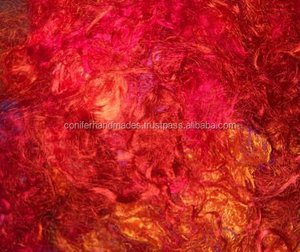
All categories
Featured selections
Trade Assurance
Buyer Central
Help Center
Get the app
Become a supplier

(16 products available)








































Sari fabric scraps refer to the remains of materials after making a sari, which is a traditional Indian garment. However, all these pieces can also be used for other purposes, such as carrying a bag, making quilts, or crafting different things. A sari is around 6.7 meters in length, and the draping part used varies from state to state. Sari fabric scraps come in various types depending on the material used to make the sari.
Cotton sari fabric scraps are one of the most commonly available and the most widely preferred for the several benefits they come with. These are because they are lightweight and breathable, making them ideal for hot weather. It is also that these scraps can be used for making home decor items, simple clothing, or in quilting, just like the cotton scraps are used.
Silk sari fabric scraps are always luxurious and glamorous and make the work a bit classy. These scraps are probably used in jewelry making, wherein the old beautiful silk saris are emboldened and designed into lovely silk wraps. Because of the weight, the fabric is suitable for making evening bags as well as other sophisticated accessories.
Usually, georgette is a kind of loose weave, and it often comes with a crinkled surface. This typing of fabric is often regarded as light and has excellent self-fall. Georgette scraps can be used in making fashionable pieces of clothing like wraps and giving a good flow. Still, they can also be used for crafting various other items such as brooches and hair clips.
Scrap from brocade saris is usually distinguished due to its richness and qayam, often embedded with intricate designs. Brocade is also usually made of cotton silk and usually comes with a patterned surface. If saved as scraps, they can also be used to make decorative items like wall hangings, which are unique and classy.
The original design of the sari determines the pattern and color of the scraps left. Sari is designed based on the culture of the people in particular regions of India. The variety of the designs ensures that the scraps can be used in many home decor, art, and design projects.
Scooters come in traditional designs, and these are mainly designed with floral or paisley motifs. These motifs are generally made of threads and gold Zari work. Zari is an embroidery type that uses threads of gold and silver. Traditional saris often have a border which is also called a ‘pallu’ and different colors of the body.
Regional and cultural differences are responsible for the divergence of the sari designs that are not necessarily traditional. For instance, Kanjivaram saris which are from Tamil Nadu, normally have square designs, and they are negotiated with rich colors. Banarasi saris from Varanasi are also well known for the lug trims of zari and intricate patterns of floral designs.
There are also some lehenga satas aimed at the wedding that come with heavy work and are made of valuable fabrics. Daily wear saris are also made of fabrics like cotton and butta impregnated with simple but beautiful works. The scraps thus reflect the ending of usage and make it possible to utilize the designs that people find very popular.
Sari fabric scraps are very versatile, and below are the most common scenarios of how these are used creatively:
Sari fabric scraps are usually used in many crafting projects and, at times, are very easy to do. These are not only ideal for novice crafters but also for more experienced artisans who make use of these scraps in making bags, wallets, and purses. Besides, the scraps can be used in decorating ordinary items such as phone covers and coasters so that they can acquire the uniqueness they have.
Sari fabric scraps can also be used in home decoration ideas. The elegant color combinations and the patterns integrated into the cotton fabric make it excellent for reclaiming. Just like cushions or throws, curtains or wall hangings can also be made using scrap fabric from a sari. In addition, using these pieces can make them give a room different but elegant charm.
Apart from using the scraps in a previous way to do things like upcycling the old beautiful silk saris to enable them to be used in jewelry making is always a good reason. This is because the remnants of thin, sometimes unbreakable fabric can be used to create necklaces, bracelets, and earrings, and most of these items have been dubbed fabric jewelry. Fabric jewelry brings some femininity and color to the outfit, thus making it possible for people to wear it.
Patchwork and quilting are some of the most common uses for sari fabric scraps. This is because each sari comes with its own colors and patterns, and the scraps are able to make distinctive quilts that contain cultural tones. Sharma has been known to use these scraps a lot more in order to make patchwork items like coasters, mug rugs, and placemats just to afford them a unique look.
As they say, "Every woman has a love-hate relationship with her wardrobe." Moreover, it might feel nice to have some extra scraps from your old beloved outfits. They can be used to uplift old clothes. This allows the recycling of pieces without throwing away the fully loved clothing.
These versatile scenarios reflect the countless potential applications for sari fabric scraps in creative and sustainable endeavors.
Though sari fabric scraps are not always manageable, it is always the responsibility of every person to make sure that the remnants are well utilized and taken care of to avoid wastage. That, in turn, means that a little bit of knowledge on the specification and maintenance of the scraps is very pertinent.
So many post-consumption wastes like plastic and cans can be treated and used, but not sari scraps. The scraps can be in several types of fabrics: cotton, silk, georgette, and brocade and each varying in texture and thickness. It should be noted that before using any scrap, one should check its state and cut it and see whether it is possible to join them or attach them to other pieces taking into account the project at hand. Further, big pieces of wearable garments can have hemlines or seams omitted so that their usable area is maximized.
This fabric takes a lot of sewing, and the crafters must be aware that some of the fabric types will need specific sewing needles to sew them. For example, sewing silk requires using a needle with a fine point to avoid piercing holes in the fabric. Also, when using the scraps, one should make use of pins and tack so that the fabric will not slip because it may easily slip when sewing it.
It is also very vital to clean the sari fabric scraps to gain long-lasting benefits from these scraps. Ideally, hand-washing these scraps in cold water with mild detergent is the best way to ensure they are not damaged. Warm water can damage delicate fabrics or colors that tend to fade. Pure silk and georgette may require dry cleaning to preserve the texture and sheen. While storing scraps, keep them in a cool, dry place and avoid exposure to direct sunlight to prevent fading.
By following these guidelines for care and maintenance, users can maximize the longevity and usability of their sari fabric scraps.
In choosing sari fabric scraps for different recycled and creative purposes, one has to factor in a lot of things. The factors can include the type of project, the material of the scrap, and the length of the scrap, among many others.
When choosing sari fabric scraps, what one should consider first is the kind of fabric used. Sari scraps can be found in a number of materials ranging from cheap cotton and expensive silk to synthetic georgette and brocade. Organic cotton is especially good for clothes due to the lightness and airiness of cotton cloth. Those who are looking for elegant and glossy material will not find anything better than silk. Soft and rugged georgette is also ideal for making, say, flowy garments. Firm brocade scraps are well known for making rich and decorative pieces.
The next factor that crafters have to take into account is the pattern and coloration of the scraps. Sari scraps are normally available in a wide range of colors and designs, ranging from simple ones to complex ones. The choice of color is, therefore, dependent on the individual preference and the task at hand. They may also combine the different colors of the remnants when making quilts or home pieces to make a more harmonious color scheme. On the other hand, fabric remnants with contrasting colors and patterns can produce dramatic items such in accessory fashion like handbags.
Further, one need not worry about the size of the scrap as even small pieces can be creatively used in various projects. Smaller scraps can be used in jewelry making or incorporating them into patchwork items. Larger pieces may be used for home decor projects or clothing alterations. Just like the length of the scrap, the condition of the fabric used should be checked, and the torn parts should be cleared to give room for a smooth sewing process.
When choosing sari fabric scraps, it lies in the material, design, and usability of the smaller pieces to bring forth a more polished outcome in any crafting or upcycling project.
A1: Sari fabric scraps are the leftover pieces of fabric after making saris. They can be used for other projects.
A2: Yes, they are great for making bags, home decor items, jewelry, patchwork, and quilting projects.
A3: The scraps should be washed by hand in cold water with mild soap. For silk, dry cleaning is recommended.
A4: A sharp sewing needle and fabric pins are helpful due to the delicacy of some fabrics, like silk and georgette.
A5: Proper storage in a cool, dry place and avoiding exposure to sunlight will help keep the scraps in good condition.